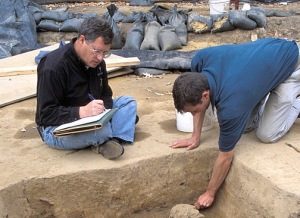
Archaeologists excavating at the site of Jamestown, the New World’s first successful English colony, have uncovered more features evidencing activity of the first English colonists who arrived on Jamestown Island, Virginia, more than 400 years ago.
Excavations in the churchyard of the 1907 Memorial Church have turned up about 70 feet of the now vanished historic James Fort palisade that defined an eastern extension of the Fort. Reports Dr. William M. Kelso, head of archaeological research at Historic Jamestowne: “The shape of this expansion also seems to be a mirror image of James Fort, where one angle of the triangle was 90 degrees and two were 45 degrees. So a bird’s eye view of the expanded fort might resemble a diamond shape.”
The eastern extension of the Fort has been documented historically, but this is the first time actual evidence of this 70-foot portion has been encountered on the ground through excavation.
Additionally, excavators have uncovered 10 long, foot-and-a-half wide, evenly spaced features extending eastward from the original James Fort space, features they believe were planting furrows dating to the first months of the 1607 settlement. If true, this would make the finding the earliest evidence of English planting, or agriculture, in the New World.
Archaeologists were able to confirm the early date of the furrows by observing that a wall line trench dated to 1608 cut through the furrow marks, clearly suggesting that the furrows predated the 1608 palisade line. These furrows also appeared to match furrows uncovered 10 years before outside the southeast bulwark of the James Fort.
Captain John Smith’s 1607 account mentions instructions given by the Virginia Company (the sponsoring organization for the Jamestown venture) to the first settlers about dividing up into groups, one third to build a fort and the others to prepare the soil and plant. Along with the growing of tobacco, which became the staple crop for the area for decades to come, the first colonists were recorded to have brought seeds of English grains with them to plant as an experiment to determine how well the English crops would grow in the New World. The seeds are documented to have included those of fruits and vegetables brought over from the West Indies (the Caribbean), such as orange trees, cotton, potatoes, melons, pineapple and pumpkins.
“This is the beginning of Southern agriculture. Agriculture — the growing of tobacco — saved the colony and set the economic pattern for the South for centuries,” said senior staff archaeologist David Givens.
“It’s remarkable that these furrows have survived, probably because they were in the churchyard and protected,” Givens added.
____________________________
Source: Edited and adapted from Where are We Digging Now?, September 2013, Jamestown Rediscovery, http://www.historicjamestowne.org/the_dig/
Cover Photo, Top Left: Archaeologists excavate at Jamestown. Smithsonian Institution Photo, Wikimedia Commons
_______________________________________________________________________________________________________________________________________________
Read about the most fascinating discoveries with a premium subscription to Popular Archaeology Magazine. Find out what Popular Archaeology Magazine is all about. AND MORE:
 Popular Archaeology’s annual Discovery edition is a selection of the best stories published in Popular Archaeology Magazine in past issues, with an emphasis on some of the most significant, groundbreaking, or fascinating discoveries in the fields of archaeology and paleoanthropology and related fields. At least some of the articles have been updated or revised specifically for the Discovery edition. We can confidently say that there is no other single issue of an archaeology-related magazine, paper print or online, that contains as much major feature article content as this one. The latest issue, volume 2, has just been released. Go to the Discovery edition page for more information.
Popular Archaeology’s annual Discovery edition is a selection of the best stories published in Popular Archaeology Magazine in past issues, with an emphasis on some of the most significant, groundbreaking, or fascinating discoveries in the fields of archaeology and paleoanthropology and related fields. At least some of the articles have been updated or revised specifically for the Discovery edition. We can confidently say that there is no other single issue of an archaeology-related magazine, paper print or online, that contains as much major feature article content as this one. The latest issue, volume 2, has just been released. Go to the Discovery edition page for more information.
Subscription Price: A very affordable $5.75 for those who are not already premium subscribers of Popular Archaeology Magazine (It is FREE for premium subscribers to Popular Archaeology). Premium subscribers should email populararchaeology@gmail.com and request the special coupon code. Or, for the e-Book version, it can be purchased for only $3.99 at Amazon.com.





